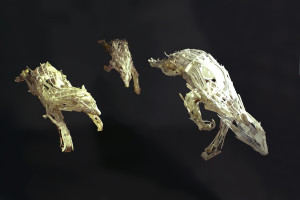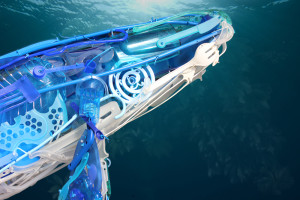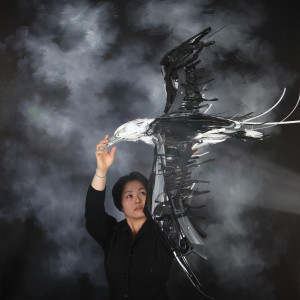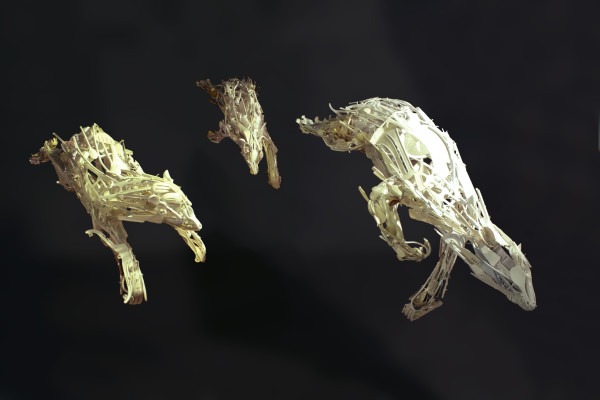Polar bears have become one of the most used symbols to represent all creatures suffering from the effects of global warming. Although all my work deals to some degree with the environmental issues due to the use of discarded plastic or metal items and depicting animal forms, Travelers was made with more conscious expression around this theme than most.
…hope is what we need
to be able to move forward
from a guilty and
depressed state of mind.
When Dr. David Wagner first called and invited me to create a piece for an exhibit titled Environmental Impact, one of the concerns he mentioned was that all of my sculptures have a very joyful energy, and he asked me how my work could fit into and contribute to the exhibition with a dark and alarming theme. “This isn’t a very happy show,” he said. My answer to him was that my work can add a sense of hope, and hope is what we need to be able to move forward from a very guilty and depressed state of mind.
Although it may have been more appropriate for this exhibition to depict polar bears stranded, starving, or otherwise under great distress, I chose to portray them happily swimming together. From up close it is obvious that the bears are all made of plastic items, but the overall viewing experience of Travelers is still mostly uplifting. The audience is invited to interpret the message as deeply as they are willing to. It can be read as a warning statement that we are steadily replacing sea life with plastic debris. It can be read as a hopeful statement that plastic items have a potential to be much greater resource than what we currently assume. It can be read as a more general statement that anything is beautiful in the right light. Or one can choose not to worry about interpretation and simply commune with the bears, to experience their joyful energy.

I do not intend to distract our attention from problems that we desperately need to face. However, when I am feeling guilty, depressed, powerless and hopeless, all I want to do is to curl up in my bed and try to hide away from the world. In the past I have become very frustrated with the lack of visible direct results from my exhibitions, workshops or lectures. I seriously doubted that my art had any influence to the people and the world. With the help from my mentor Chris Jordan, now I am more able to trust that my work can have a positive effect on viewers, but in more subtle, indirect ways of reinforcing the love and awe of nature in each of us as well as showing the beauty and possibility that exist in any material.
I think we crave beauty just like we crave food or water, and beauty can elevate the value of plastic items in our minds. If we can see enough aesthetic value in a sculpture made of plastic debris, we can quiet the voice in our heads that whisper “I got this plastic spoon for free and it is worthless”. Then we can detach monetary value from the object and really see the potential for all it could be. When we look at the Great Pacific Garbage Patch, we see a huge problem and it’s difficult to see anything but a problem. But for us to be able to solve this, we need to also see potential value and resources that can be extracted from this situation. And we need to stop trying to trade our own time for someone else’s as if we are dealing with commodities.

So we compare two minutes
of our time to the monetary
value of a disposable item.
Disposable plastic items may have been invented to alleviate a social difficulty. Our lives were so busy and people were struggling to find enough time in their days to get all the chores done. Maybe we just wanted to buy a little extra time to enjoy with friends and family. But it seems to me that now more than ever, we have such strong fear and anxiety about running out of time. We are not getting enough done, saving enough money, or accumulating enough accomplishments. So we compare two minutes of our time to the monetary value of a disposable item. In this math, anything that is cheap enough for us to keep buying more of gets tossed aside and temporarily forgotten. Those with more money can naturally afford to buy more time to engage in activities that they deem to be more important. What many of us have been leaving out of the equation is the hidden social and environmental tolls that continue to accumulate, and are already returning into our lives in forms of diseases, climate change, increased inequality, etc.
I’m just as guilty as the next person of feeling like I have better things to do with my time. This is my fear and anxiety talking. There are so many quotes about how you should live every day as if it is your last day. When interpreted through fear, this might prompt us to prioritize our tasks for the day in order of perceived importance and avert our eyes from the waste being produced or messes being left behind for someone else to pick up. We are competing against one another for points, as if rarer and more pleasurable activities have higher intrinsic value than more common or painful ones.
Then the value of a moment
depends instead on how
fully we experience it, or
what we learn from it.
My Zen mentor Rinsen once told me that if I’m fully present in the moment, I can find washing dishes just as interesting and gratifying as making sculpture. If we interpret the same quote through appreciation for every moment, maybe we can enjoy washing the dishes as if it is our hearts being cleansed, feel the gentle breeze that takes out moisture from hung linens, and truly believe there is no difference in value between a moment in spotlight on stage, on a great adventure, savoring one’s favorite food, or doing the most menial task that needs to be done. Then the value of a moment depends instead on how fully we experienced it, or what we learn from it.
If we can let go of our preoccupation with convenience and saving time, then perhaps we can be gentler and more respectful toward the entire world of beings around us.

Sayaka Kajita Ganz was born in Yokohama, Japan and grew up living in Japan, Brazil, and Hong Kong. Now residing in the United States, Ganz continues to be influenced by the Japanese Shinto belief that all objects and organisms have spirits. Holding a great passion for fitting shapes together and sympathy for discarded objects, Ganz creates animals and natural forms exclusively from reclaimed plastics.
“My goal is for each object to transcend its origin by being integrated into a new form that releases them from the stagnant state into something alive and resilient.”
Ganz earned a Master of Fine arts in 3D Studies with a concentration in sculpture from Bowling Green State University and a Bachelor of Fine Arts in Printmaking with a minor in Theatre and Drama from Indiana University Bloomington.
The sculpture Travelers featured in this post is currently on display in the traveling museum exhibition Environmental Impact. The solo exhibition, Reclaimed Creations, featuring ten of Ganz’s captivating sculptures will be begin touring in July of 2017. Additional tour dates are available and further exhibition details can be found here for those interested [Japanese pg1 & pg2].
Edited to Add: Learn more about Sayaka Ganz in the short film Danze della Natura from Anonio Chiavacci:
This post is part of the MAHB’s Arts Community space –an open space for MAHB members to share, discuss, and connect with artwork processes and products pushing for change. Please visit the MAHB Arts Community to share and reflect on how art can promote critical changes in behavior and systems and contact Erika with any questions or suggestions you have regarding the new space.
MAHB-UTS Blogs are a joint venture between the University of Technology Sydney and the Millennium Alliance for Humanity and the Biosphere. Questions should be directed to joan@mahbonline.org
MAHB Blog: https://mahb.stanford.edu/blog/travelers/
The views and opinions expressed through the MAHB Website are those of the contributing authors and do not necessarily reflect an official position of the MAHB. The MAHB aims to share a range of perspectives and welcomes the discussions that they prompt.
